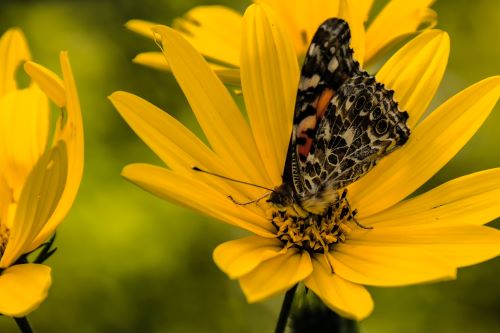A pollinator garden at school offers students all the emotional, academic, and physical benefits of gardening while also introducing them to deeper environmental concepts and concerns. The benefits of gardening include improved focus, lessened anxiety, and boosted memory. Studies show that children who garden have better science and math skills, even scoring higher on standardized tests. Gardening at home with family is a different experience than communal gardening at school. There are opportunities for teachers to guide children in lessons outside the classroom. Creating a school garden, though, requires commitment and time. Teachers need to ask themselves a few questions to determine how sustainable the garden project will be and who will ultimately be responsible for its coordination and care.
What is a Pollinator Garden?
Pollinator gardens serve a larger purpose than merely supplying food for some insects through a few flowers. A pollinator garden is a complete habitat that provides food, nesting areas, and overwintering sites for a variety of pollinators including butterflies, native bees, moths, beetles, and others. Planting a few flowers to feed pollinators but continuing harmful landscape maintenance such as leaf blowing and spraying weed killer, will negate any good the flowers might have provided. Before embarking on a school garden, talk with your school’s administrators to review the best practices for pollinator gardening and secure parental approval for children to participate, especially ones with allergies. Changing the way organizations interact with the land they are built on is a big step in role-modeling ecologically sound stewardship.
Questions to Ask Before Starting a Garden
School projects require research and planning before the work begins. Following a thoughtful list of steps will assure that the project will be completed successfully. Before starting to dig a new garden bed, take some time to research the optimal place for it and determine how it will be maintained. The adage “too many cooks spoil the broth” aptly foreshadows what happens when a pollinator garden has no specific coordinator in charge: perennial plants will be mistakenly weeded out, others will wilt from underwatering or rot from overwatering, yet others will be attractive plants without any value for pollinators—ultimately it will cost the school wasted time and money. Ideally a single teacher or administrator must lead the creation and maintenance of the garden. This person will design the physical shape of the bed and its size; choose plants appropriate for the garden’s sun/shade balance and soil type; coordinate volunteers and, if no one comes for their time slot, be prepared to perform the necessary task. With a single person taking responsibility, the garden will be created, planted, sustained, and maintained without disruption.
Here are a few questions to consider when the garden is being planned:
- What is the best location for the garden? In winter and spring, pollinator gardens look a bit wild or messy. Ask if your school is willing to use that as an educational opportunity to role-model a new ecologically-based landscape aesthetic or if the garden would be better placed in a less conspicuous space.
- What are the soil and water conditions of the garden site?
- Is there an outside water source nearby? Is it possible to install a rain barrel?
- What is the budget for plants and garden tools? A pollinator garden is usually a combination of native perennial flowers, which come back every year, and annuals, which bloom once a year. A small budget will be needed each year.
- Is it possible to get donations from local plant nurseries? If so, who will contact them? And who will confirm they only supply plants that are not treated with pesticides and weed killers?
- Who will research the best native perennials for pollinators in your area and where to purchase them? Good places to start include the Native Plant Society of North America.
- Is it possible to find sponsorship for the garden from a garden club or other organization?
- Who is the lead on the pollinator garden team?
- Which classes will participate in spring plantings? Who will decide?
- Who will be in charge over the summer?
- Is there adequate time to train summer staff how to care for the garden?
- Is there a way to implement the garden in summer programs so children can observe the process of butterflies changing from caterpillar to chrysalis to butterfly?
- Does administration support the creation of the garden?
- Does administration agree to banning weed killers, fertilizers, and pesticides, from the school’s landscape?
- What type of signage can the school afford to create for the garden? Or can students create educational signage?
Best Practices for Pollinator Gardening
Do not use weed killers, pesticides, herbicides, or fertilizers
Check with your school administration to confirm that no weed killers are used by landscaping companies on school grounds. While the European Union is banning pollinator killing chemicals, the United States has not thus far. These cancer-causing chemicals pollute our drinking water and have even been found in the Arctic. In garden beds, try hand weeding. This is great for building hand strength and children’s fine motor control. Note that many fertilizers contain weed killers. Fertilizers are not needed in flower gardens.
Do not rake up fallen leaves or use a leaf blower on garden beds
Most butterfly and moth larvae need fallen leaves to nest in the summer and over winter during the cold months. Other butterflies and moths spend their winters in chrysalides or cocoons so they need branches to hang from. Meanwhile, many non-aggressive, solitary native bees curl up in the hollow of dead flower stems. A “neat” garden means no pollinators. Allow a layer of fallen leaves to stay on top of the garden through the winter and spring. When planting new flowers simply push leaves aside. Plants are not hindered by leaf cover. It is a natural process.
Plant both host plants and nectar plants
Butterflies and moths require specific plants to lay eggs on, called host plants. Monarchs, the most famous pollinator, need milkweed. Most host plants will be native perennial flowers (native to a geographical area and a plant that returns yearly). Connect with the North American Butterfly Association and your local chapter of the North American Native Plant Society to see which plants are suitable for your pollinator garden.
Let the school lawn go natural
Americans use 10x more pesticides on lawns than farmers do on crops. These chemicals are often hidden in fertilizers and even coated around grass seeds. Encourage your school to allow lawn areas to go natural with clover and dandelions. Or if they are willing to explore more ecological options, consider planting a no-mow lawn, employing the mosaic mowing technique, or planting a meadow.
Do not cut down old trees (snags)
Old or dead trees offer excellent nesting and over wintering areas for pollinators. An old or dead tree even as short as 6 feet will provide pollinator habitat.
Citizen Science
Pollinator gardens offer students many academic benefits while also getting children outside and interacting with the natural world. With smartphones and tablets, classes can engage in citizen science and contribute local data for scientists to gain a better understanding of biodiversity changes and challenges. Older grades, especially, can take advantage of this new trend that connects technology and nature in a unique way by reporting monarch butterfly sightings and number of caterpillars sustained by the garden. These observations contribute to ways conservation organizations are addressing the crisis. Children become stewards of the land on which we live and grow food. They become active participants by contributing their observations and data in a larger context.
Creating a pollinator garden at school is a long term commitment, but one that will offer learning opportunities throughout the year for years to come. Start small and consult your Native Plant Society chapter to source perennials that have the best chance of growing well in your school’s garden. Not every plant will take and not every flower will bloom. Caterpillars will sometimes gobble up an entire plant (monarch caterpillars are especially voracious, so plant a lot of milkweed if you intend to support them). Students will learn that observing the garden’s changes in even small ways—a leaf being eaten, a fallen flower—are signs of a diverse and healthy habitat. In turn, they will hopefully be the generation to embrace ecologically beneficial landscaping practices and turn the pollinator crisis around.
Resources
Lady Bird Johnson Wildflower Center database
Native Plant Society of North America
For flower suggestions and specific steps to create a pollinator garden, check our post, Gardening With Your Child: How to Create a Pollinator Garden at Home.


